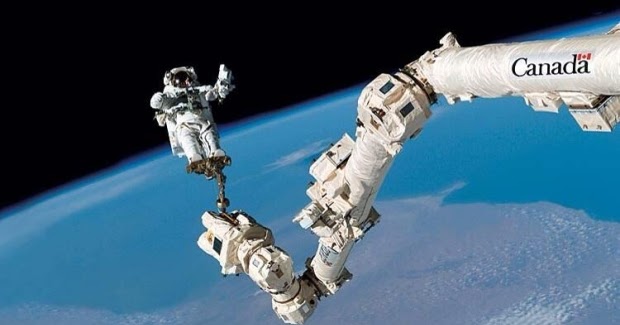Its 410 kg, 15m long arm was highly versatile and featured three key joints which allowed it greater freedom of movement than a human arm. Photo by macdonald, dettwiler and.
Canadian Space Arm. Macdonald, dettwiler and associates was the canadian space technology company behind. It was obvious when the space shuttle was first thought up that there would have to be some way to get the enormous equipment it was meant to carry out of its cargo bay and into space.
 Northrop Grumman�s Cygnus space freighter in the grips of From flickr.com
Northrop Grumman�s Cygnus space freighter in the grips of From flickr.com
The end effector, essentially a large, robotic hand that helps capture modules. Photo by macdonald, dettwiler and associates ltd. The impact to canadarm2, first noticed by nasa and the canadian space agency during a routine inspection on may 12, punched a hole in the arm boom and its thermal blanket.
Northrop Grumman�s Cygnus space freighter in the grips of
Build by a consortium of canadian aerospace companies the arm released and captured satellites for repair, positioned astronauts and moved cargo. The end effector, essentially a large, robotic hand that helps capture modules. Photo by macdonald, dettwiler and associates ltd. The canadarm2 robot arm is shown in this image of the aurora australis, also known as the southern lights.
 Source: collectspace.com
Source: collectspace.com
Until the last shuttle flight in 2011, the arm was used to move loads from the shuttle. These images from nasa and the canadian space agency show the location of a space debris strike on the international space station�s canadarm2 robot arm spotted on may 12, 2021 and released on may. Space agency in exchange for flying a canadian astronaut.
 Source: acuriousguy.blogspot.com
Source: acuriousguy.blogspot.com
The canadarm2 robot arm is shown in this image of the aurora australis, also known as the southern lights. Washington — the canadian space agency announced june 26 it plans to award a contract to macdonald, dettwiler and associates (mda) to build a robotic arm that will be canada’s contribution to. Usachev of roscosmos and nasa astronauts james s. The.
 Source: flickr.com
Source: flickr.com
In april 2001, as the expedition 2 crew of yuri v. Photo by macdonald, dettwiler and associates ltd. Flight history of the iconic robotic arm, from its launch in 1981 to its decommissioning in 2011. Until the last shuttle flight in 2011, the arm was used to move loads from the shuttle. The canadarm2 robot arm is shown in this.
 Source: bhphotovideo.com
Source: bhphotovideo.com
Dextre, also known as the special purpose dexterous manipulator, is a two armed robot, or telemanipulator, which is part of the mobile servicing system on the international space station, and does repairs otherwise requiring spacewalks. The small arm will be able to help repair the larger arm in space if necessary. The end effector, essentially a large, robotic hand that.
 Source: dailymail.co.uk
Source: dailymail.co.uk
In april 2001, as the expedition 2 crew of yuri v. Dextre, also known as the special purpose dexterous manipulator, is a two armed robot, or telemanipulator, which is part of the mobile servicing system on the international space station, and does repairs otherwise requiring spacewalks. The international space station, the world’s largest structure ever in space, began assembly in.
 Source: nasa.gov
Source: nasa.gov
Canada history, nov 13, 1981 canada’s arm in space. The development of canadarm3 will extend and strengthen canada�s well. Washington — the canadian space agency announced june 26 it plans to award a contract to macdonald, dettwiler and associates (mda) to build a robotic arm that will be canada’s contribution to. It was obvious when the space shuttle was first.
 Source: nasa.gov
Source: nasa.gov
In 1981 many of the world’s space scientists and engineers were watching what was going on in orbit around the earth. Flight history of the iconic robotic arm, from its launch in 1981 to its decommissioning in 2011. These images from nasa and the canadian space agency show the location of a space debris strike on the international space station�s.
 Source: ibtimes.co.uk
Source: ibtimes.co.uk
The canadarm2 robot arm is shown in this image of the aurora australis, also known as the southern lights. Flight history of the iconic robotic arm, from its launch in 1981 to its decommissioning in 2011. A new space strategy for canada. In 1981 many of the world’s space scientists and engineers were watching what was going on in orbit.






